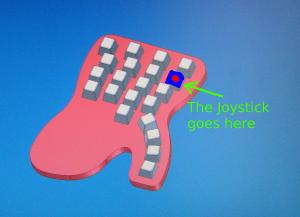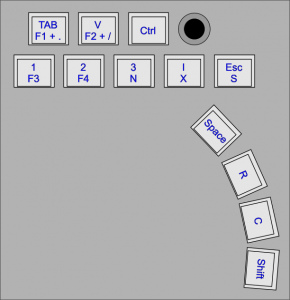
|
 Home Home
 Projects Projects
 Experiments Experiments
 Circuits Circuits
 Theory Theory
 BLOG BLOG
 PIC Tutorials PIC Tutorials
 Time for Science Time for Science
|
| ||
|
7 August 2010 Author: Giorgos Lazaridis Men Of War Game ConsoleWorklog - Controller Designs (August 7 2010) This is the very first design of the controller. I call it the "cooking glove": 
There are 4 rows with 4 buttons each (except the 2nd wor that has the joystick). All these buttons are pressed with the 4 fingers of the left hand, and the joystick is controlled with the pointing finger. The row with the joystick is the "main row" that the fingers will lay all the time. For to click the other buttons, the fingers must move up or down, similar like the "blind typing" system on the keyboard. There are also 4 more buttons on the right side. These buttons are controlled with the thumb, so i call them "thumb buttons". And finally, there is one more button in the middle of nowhere, that will simulate the "esc" button and will be pressed with the pointing finger. Free courses for blind typing Ok let's be realistic. The above design is too complicated. I mean, ok, i do have all the shortcuts, but frankly, i do not know if i will be able to use them. I will need to practice A LOT for my fingers to learn the positions. So i decided to lighten up the design. This would result in reducing the shortcuts... Yuck! I want as more shortcuts as possible! And that is how the Shift was invented! Imagine the scene: Two top-scientist are discussing in the R&D of IBM, about how many keys should a keyboard -the very first keyboard ever- have...
Dr. Moose: "What? And what about the 26 letters?" Dr. Papas: "26 small and 26 capital...And... also 4 arrow keys for th 4 directions, and some special keys like home, end, page up. And a numeric keypad... I think we need about 210 keys"... And that is how possible the "Shift" key was invented, which is exactly how it was invented in my case... I will turn the bottom right thumb-button into a shift, giving double functionality to all other buttons, except of course the other 3 thumb-buttons. I will reduce the button rows in 2, and i will add another button to the 2nd row. To further zip the buttons, i will merge the F1 with the . together, and the F2 with the / key. That is why the .(Change ammo (HE-AP)) and the / (Next machine gun) are effective only when controlling Tanks, while F1 (select frag grenade) and F2 (select AT grenade) are effective only when controlling infantry. This means that if i press the F1+. button, the controller will send both the F1 and the dot (.), but only the shortcut that has an effect will be taken into account by the game. So here is the layout. There are 2 lines in each key. The top line is the shifted: 
Getting the keys If you want to have keyboard-feel keys, then use keyboard keys... I always keep my old (and broken) keyboards for their controllers. Yet, older keyboards used to have pushbuttons to their keys (and that is the reason why keyboards used to cost a huge load of money). Luckily, i had such a keyboard in my museum:
As for the joystick, i got it from E-Bay. It is supposed to be an analog joystick, but the trimmers that it has are worst than junk. The seller got a negative feedback from me, i am sorry. Also, the pushbutton action that the joystick has needs too much force. That is why i do not use the joystick pushbutton action and i removed the button to reduce space. Then i began soldering the keys into a pre-drilled PCB. I had also print-outs with the approximate position for the keys: As for the buttons, i had to remove the letters and symbols:
Comments
|
|
 Contact Contact
 Forum Forum
 Projects Projects
 Experiments Experiments
 Circuits Circuits
 Theory Theory
 BLOG BLOG
 PIC Tutorials PIC Tutorials
 Time for Science Time for Science
 RSS RSS
Site design: Giorgos Lazaridis © Copyright 2008 Please read the Terms of services and the Privacy policy |